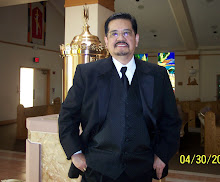Santa Magdalena (Mary Magdalene) has been with his family for maybe ninety years or so. The other Santo in our family, Santa Veronica, should also be the same age as Magdalene.
The Santo which is now under our care, another Saint Magdalene, has been in the family of its original Bustos-based clan for over forty years. The family's old Saint Magdalene was gutted by fire in the 70's.
Our local church's Holy Week procession was held for three days this year as in other years past. It was held on Holy Wednesday, Good Friday and Easter Sunday.
This year, the local church's Patron Saint, San Andres Apostol, had been assigned to the Biblical Apostolate committee. It meant taking care of the carrozza (carriage), its decoration and management of the image in all the processions.
 | |||||||
| San Andres Apostol during the Holy Wednesday procession |
The Gospel of John states that Andrew was a disciple of John the Baptist, whose testimony first led him, and another unnamed disciple of John the Baptist, to follow Jesus. Andrew at once recognized Jesus as the Messiah, and hastened to introduce him to his brother. Hence forth, the two brothers were disciples of Christ. On a subsequent occasion, prior to the final call to the Apostolate, they were called to a closer companionship, and then they left all things to follow Jesus.
 |
| Fr. Vic Flores, Parish Priest of San Andres Apostol Parish, blesses the Image before the procession |
Andrew is said to have been martyred by crucifixion at the city of Patras (Patræ) in Achaea, on the northern coast of the Peloponnese. Early texts, such as the Acts of Andrew known to Gregory of Tours describe Andrew as bound, not nailed, to a Latin cross of the kind on which Jesus is said to have been crucified; yet a tradition developed that Andrew had been crucified on a cross of the form called Crux decussata (X-shaped cross, or "saltire"), now commonly known as a " Saint Andrew's cross" — supposedly at his own request, as he deemed himself unworthy to be crucified on the same type of cross as Jesus had been."
"The familiar iconography of his martyrdom, showing the apostle bound to an X-shaped cross, does not seem to have been standardized before the later Middle Ages," Judith Calvert concluded after re-examining the materials studied by Louis Réau.
Andrew preached in Scythia. The Chronicle of Nestor adds that he preached along the Black Sea and the Dnieper river as far as Kiev, and from there he traveled to Novrogon. Hence, he became a patron saint of Ukraine, Romania and Russia. According to tradition, he founded the See of Byzntium, (Constantinople) in AD 38, installing Stachys as bishop.
According to Hippolytus of Rome, he preached in Thrace, and his presence in Byzantium is also mentioned in the apocryphal Acts of Andrew, written in the 2nd century; Basil of Seleucia also knew of Apostle Andrew's mission in Thrace, as well as Scythia and Achaia. This diocese would later develop into the Patriarchate of Constantionople. Andrew is recognized as its patron saint.
 |
| Early Easter Procession after the Philippine Catholic rite of Salubong, where the images of the Risen Christ and the Virgin Mary meet up at dawn |






